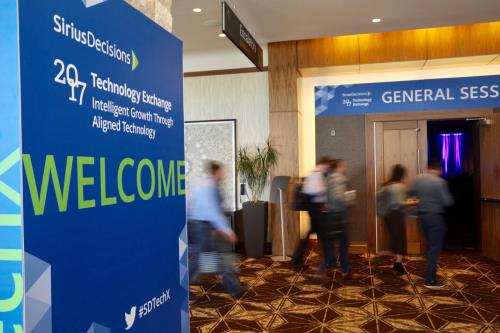SiriusDecisions TechX 2017 Highlights: How Do You Justify a Technology Purchase?
- The 2017 SiriusDecisions Technology Exchange has kicked off in Austin
- Gil Canare opened the conference with a compelling keynote on internal justification for tech purchases
- Organizations should focus on purchase drivers and the impact profile of any potential technology
You’ve found the perfect technology solution for your organization. Now, how do you convince everyone else to approve it and get that contract signed?
Creating an internal business justification for a tech purchase is an essential step of the buying process. But with more technology options available than ever – and budgetary pressures often increasing – justifying each purchase can be challenging.
Building a business case for a tech purchase requires satisfactory answers to two questions – ‘Why this solution?’ and ‘Why now?’” explained Gil Canare during his opening keynote at the SiriusDecisions Technology Exchange in Austin.

“We all agree that technology will continue to be a critical part of our success,” Gil said. “But as buying decisions get more complicated and more people are involved, you need to be able to address everyone’s concerns. Many organizations struggle with this.”
Answering the “Why this solution?” question tends to be the easier question to answer, given the wealth of information on various solutions available from vendors and third parties. “Why now?” is trickier because it requires not only arguing a new approach to solving a problem, but also proving its importance over other pressing priorities.
To help organizations answer both questions, Gil unveiled a new process for creating an effective purchase justification. The first step is to analyze the specific purchase drivers – whether internal, external or a combination of the two. While anything from regulatory or legal changes to a desire for a particular capability in the tech stack is valid, flimsier reasons (e.g. “It’s just a really cool technology”) are likely a sign that the purchase ultimately can’t be justified.
Next, direct and indirect opportunity costs should be carefully considered. “You must be able to define the impact of the purchase and make the case that over the long term, it’s going to be the better option,” Gil said.
Developing the full impact profile of a technology purchase requires examining four impact areas – costs, organization, processes and skills – and deciding whether the purchase’s overall impact is small (the organization’s existing budget and structure can easily absorb the purchase), medium (significant changes within one impact areas) or large (major changes in multiple impact areas).
Finally, organizations must look at purchase type, which determines the amount of justification needed to gain consensus, as well as some common questions and objections. For example, a forced purchase – driven by external factors such as competitive pressures or vendor issues – typically has major cost impacts. Additionally, this purchase type often provokes questions on why the situation requiring the purchase occurred or why it was not addressed proactively.
Transformational purchases, in contrast, may be driven by a mix of internal and external factors (e.g. competitive pressures, a need for new capabilities). Because of their widespread impact, justifying them means demonstrating the value of the purchase across several dimensions and functions.
“Your justification must align to what your company measures, whether that’s leads or deal velocity or something else,” Gil noted. “You need to be able to draw a direct line from purchase to value.”
The third purchase type – incremental – often draws questions on whether the benefits to be gained from the new technology could be more easily obtained through another method, such as hiring an intern or changing an internal process. As with transformational purchases, “Is it worth it?” is the key question that must be answered.
Rationalization purchases focus on cost savings and tech stack management. “Ideally, the impact is small, but these purchase affect processes, skills and the organization,” Gil said. “You’ll need to justify very clearly why this is the right solution.”
For getting sign-off on any type of tech purchase, preparation is essential. Anticipate the questions that likely will be asked, and develop answers in advance, Gil advised. Coupled with sound purchase drivers and a deep understanding of the purchase’s impacts across the organization, a well-presented case offers the best chance of gaining consensus and seeing that much-desired technology purchase happen.